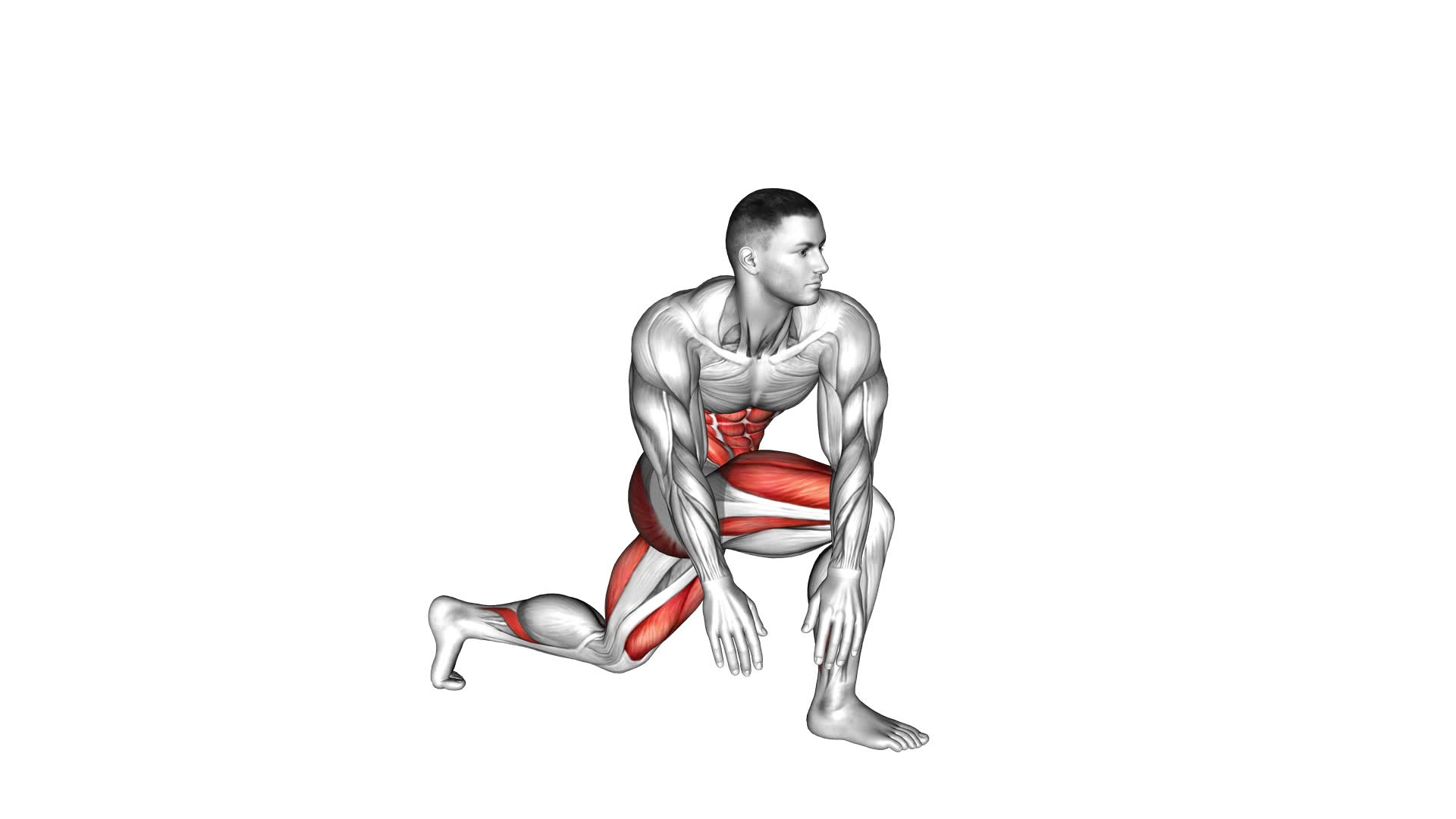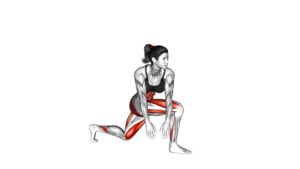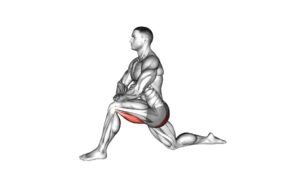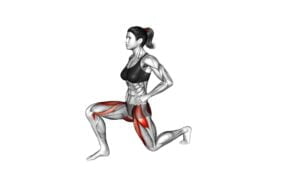Crossover Kneeling Hip Flexor Stretch (male) – Video Exercise Guide & Tips

In this video exercise guide, you'll learn how to properly perform the crossover kneeling hip flexor stretch. This stretch is great for targeting your hip flexor muscles and improving flexibility.
Watch This Exercise Video
Avoid common mistakes and find variations that suit your fitness level.
Plus, discover tips for incorporating this stretch into your regular workout routine.
Get ready to stretch and feel the benefits in no time!
Key Takeaways
- Maintains hip flexor flexibility
- Improves overall performance in physical activities
- Prevents hip flexor injuries
- Enhances range of motion
Benefits of the Crossover Kneeling Hip Flexor Stretch
To maximize the effectiveness of your workout routine, incorporate the Crossover Kneeling Hip Flexor Stretch for its numerous benefits.
One of the main benefits of this stretch is its importance in maintaining hip flexor flexibility. The hip flexors are a group of muscles located in the front of your hip joint that play a crucial role in everyday movements such as walking, running, and even sitting. By regularly stretching the hip flexors, you can improve their flexibility and range of motion, which can lead to better overall performance in physical activities.
Another benefit of the Crossover Kneeling Hip Flexor Stretch is its ability to prevent hip flexor injuries. Tight hip flexors can increase the risk of strains or tears in the muscles, which can be painful and limit your ability to move freely. By regularly stretching these muscles, you can help prevent these injuries and maintain healthy hip flexors.
Incorporating the Crossover Kneeling Hip Flexor Stretch into your workout routine can have a significant impact on your hip flexor flexibility and injury prevention. By taking a few minutes each day to perform this stretch, you can improve your overall performance and reduce the risk of hip flexor injuries.
Proper Form and Technique for the Stretch
To perform the Crossover Kneeling Hip Flexor Stretch properly, follow these guidelines to ensure proper form and technique.
Start by kneeling on the floor with one leg forward and the other leg bent at a 90-degree angle behind you. Keep your torso upright and engage your core for stability. Place your hands on your hips for balance.
To begin the stretch, shift your weight forward onto your front leg. You should feel a stretch in the hip flexor of the back leg. Make sure to keep your back straight and avoid arching it. Hold the stretch for 20 to 30 seconds, then switch sides and repeat.
Now, let's discuss some common mistakes to avoid. One mistake is leaning too far forward, which can strain the lower back. Another mistake isn't keeping the back leg at a 90-degree angle, which reduces the effectiveness of the stretch. Remember to focus on maintaining proper alignment and engaging the correct muscles.
There are also variations and modifications you can try. If kneeling is uncomfortable, you can perform this stretch while standing. Another modification is using a yoga block or cushion under the back knee for additional support.
Common Mistakes to Avoid During the Stretch
When performing the Crossover Kneeling Hip Flexor Stretch, it's important to be aware of common mistakes to avoid in order to properly engage the correct muscles and prevent strain or reduced effectiveness of the stretch. Here are some common mistakes to watch out for and tips on how to perform the stretch with proper technique:
- Rounding the back: Avoid rounding your back during the stretch as this can put unnecessary strain on your spine. Instead, maintain a straight and upright posture throughout the exercise.
- Lifting the front foot too high: Many people tend to lift their front foot too high off the ground, which can lead to imbalance and instability. Keep your front foot grounded and stable while performing the stretch.
- Not engaging the glutes: To fully engage the hip flexor muscles, it's important to also activate the glutes. Squeeze your glutes and engage your core muscles while performing the stretch to ensure proper muscle engagement.
Variations and Modifications for Different Fitness Levels
Start with the appropriate variation of the Crossover Kneeling Hip Flexor Stretch based on your fitness level. If you're a beginner, it's important to start slowly and focus on proper form. A modified version of the stretch can be done by placing a cushion or folded towel under your knee for added support. This will help alleviate any discomfort and allow you to focus on the stretch itself.
As you progress and become more comfortable with the stretch, you can advance to more challenging variations. One advanced variation involves adding a twist to the stretch by rotating your torso towards the side of the front leg. This will increase the intensity of the stretch and engage the muscles in your core as well.
Another advanced variation is to perform the stretch with a stability ball. Place the ball against a wall and position your front foot on top of it, while kneeling on the ground. This variation provides a deeper stretch and increases the stability challenge.
Tips for Incorporating the Stretch Into Your Workout Routine
To incorporate the Crossover Kneeling Hip Flexor Stretch into your workout routine, focus on maintaining proper form and gradually increasing the intensity of the stretch. Here are some tips to help you effectively incorporate this stretch into your routine:
- Warm-up: Before starting the stretch, make sure to warm up your muscles by performing some light cardio exercises or dynamic stretches. This will help prepare your body for the stretch and reduce the risk of injury.
- Proper form: To get the most out of the stretch, it's important to maintain proper form. Start by kneeling on one knee with the other leg extended in front of you. Keep your back straight and engage your core. As you lean forward, make sure to keep your hips squared and pelvis tucked under.
- Gradually increase intensity: As you become more comfortable with the stretch, you can start increasing the intensity. This can be done by leaning further forward or by adding a gentle twist to the side. However, remember to listen to your body and only go as far as feels comfortable for you.
Frequently Asked Questions
Can the Crossover Kneeling Hip Flexor Stretch Help With Lower Back Pain?
The crossover kneeling hip flexor stretch can be a helpful exercise for relieving lower back pain. By stretching the hip flexor muscles, you can reduce tension and improve flexibility in the area.
However, it's important to note that there are also other alternative exercises for lower back pain relief. These may include exercises that target the core muscles and promote proper posture.
Consulting with a healthcare professional can help determine the best hip flexor pain treatment for you.
Is It Safe to Perform the Stretch if I Have a Knee Injury?
If you have a knee injury, it's important to be cautious when performing the crossover kneeling hip flexor stretch. This stretch can put strain on the knees and potentially worsen your injury.
To modify the stretch, you can use a cushion or folded towel under your knee for added support.
Additionally, there are alternative stretches that target the hip flexors without putting strain on the knees, such as the standing quad stretch or the seated butterfly stretch.
How Often Should I Perform the Crossover Kneeling Hip Flexor Stretch to See Results?
To see results from the crossover kneeling hip flexor stretch, focus on the frequency and duration of the stretch. Aim to perform this stretch at least three to four times a week. Each time, hold the stretch for about 30 seconds on each side.
Consistency is key here, so make sure to incorporate this stretch into your regular exercise routine for the best outcome.
Can This Stretch Improve My Flexibility for Other Exercises Such as Squats or Lunges?
Improving your mobility is essential for performing exercises like squats and lunges effectively.
Stretching, like the crossover kneeling hip flexor stretch, can help increase your flexibility, allowing you to achieve a greater range of motion in these exercises.
By regularly incorporating this stretch into your routine, you can reap the benefits of improved hip flexibility.
This improved flexibility can translate into better form, increased strength, and reduced risk of injury during squats and lunges.
Are There Any Specific Breathing Techniques That Should Be Used During the Stretch?
During the stretch, it's important to focus on your breathing. Take deep breaths in and out as you perform the Crossover Kneeling Hip Flexor Stretch. This will help you relax and get the most out of the stretch.
As for modifications for beginners, you can start by holding onto a chair or wall for support. Gradually increase the intensity of the stretch as you become more comfortable.
Conclusion
In conclusion, the crossover kneeling hip flexor stretch is a beneficial exercise for improving hip flexibility and relieving tightness.
By maintaining proper form and avoiding common mistakes, you can effectively target your hip flexors and prevent injury.
Whether you're a beginner or advanced in fitness, there are variations and modifications available to suit your needs.
Incorporating this stretch into your workout routine can enhance your overall flexibility and contribute to better performance in various activities.

Author
Years ago, the spark of my life’s passion ignited in my mind the moment I stepped into the local gym for the first time. The inaugural bead of perspiration, the initial endeavor, the very first surge of endorphins, and a sense of pride that washed over me post-workout marked the beginning of my deep-seated interest in strength sports, fitness, and sports nutrition. This very curiosity blossomed rapidly into a profound fascination, propelling me to earn a Master’s degree in Physical Education from the Academy of Physical Education in Krakow, followed by a Sports Manager diploma from the Jagiellonian University. My journey of growth led me to gain more specialized qualifications, such as being a certified personal trainer with a focus on sports dietetics, a lifeguard, and an instructor for wellness and corrective gymnastics. Theoretical knowledge paired seamlessly with practical experience, reinforcing my belief that the transformation of individuals under my guidance was also a reflection of my personal growth. This belief holds true even today. Each day, I strive to push the boundaries and explore new realms. These realms gently elevate me to greater heights. The unique combination of passion for my field and the continuous quest for growth fuels my drive to break new ground.







